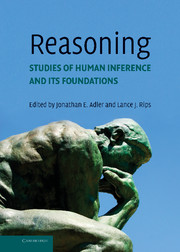Book contents
- Frontmatter
- Contents
- Preface
- List of Contributors
- Introduction: Philosophical Foundations
- PART I FOUNDATIONS OF REASONING
- PART II MODES OF REASONING
- Section 3 Deductive Reasoning
- 9 Logical Approaches to Human Deductive Reasoning
- 10 Mental Models and Deductive Reasoning
- 11 Interpretation, Representation, and Deductive Reasoning
- 12 Reasoning with Quantifiers
- 13 The Problem of Deduction
- Section 4 Induction
- Section 5 Dual and Integrative Approaches
- Section 6 Abduction and Belief Change
- Section 7 Causal and Counterfactual Reasoning
- Section 8 Argumentation
- PART II INTERACTIONS OF REASONING IN HUMAN THOUGHT
- Index
- References
11 - Interpretation, Representation, and Deductive Reasoning
Published online by Cambridge University Press: 05 June 2012
- Frontmatter
- Contents
- Preface
- List of Contributors
- Introduction: Philosophical Foundations
- PART I FOUNDATIONS OF REASONING
- PART II MODES OF REASONING
- Section 3 Deductive Reasoning
- 9 Logical Approaches to Human Deductive Reasoning
- 10 Mental Models and Deductive Reasoning
- 11 Interpretation, Representation, and Deductive Reasoning
- 12 Reasoning with Quantifiers
- 13 The Problem of Deduction
- Section 4 Induction
- Section 5 Dual and Integrative Approaches
- Section 6 Abduction and Belief Change
- Section 7 Causal and Counterfactual Reasoning
- Section 8 Argumentation
- PART II INTERACTIONS OF REASONING IN HUMAN THOUGHT
- Index
- References
Summary
A View with no Room
Is the psychology of deduction about the few well-known laboratory tasks in which subjects are presented with logical puzzles and asked to solve them: the selection task, syllogisms, the suppression task, conditional reasoning, …? And if our capacity of deduction is not just for performing these tasks, what is it for? What everyday functions does it serve? How are theoretical analyses of deductive performance in these laboratory tasks related to analyses of other cognitive functions?
From the position of being absolutely central in the cognitive revolution, which was founded on conceptions of reasoning, computation and the analysis of language, the psychology of deduction has gone to being the deadbeat of cognitive psychology, pursued in a ghetto, surrounded by widespread scepticism as to whether human reasoning really happens outside the academy. “Isn't what we really do decision?” we increasingly often hear. Many eminent psychology departments do not teach courses on reasoning. Imagine such a psychology department (or indeed any psychology department) not teaching any courses on perception. Even where they do teach reasoning they are more likely to be focused on analogical reasoning, thought of as a kind of reasoning at the opposite end of some dimension of certainty from deduction.
We believe that the reason for this ghettoisation can be traced to a series of assumptions which we will consider shortly. We will argue that the way out of the ghetto is to drop these assumptions, none of which bears scrutiny anyway.
- Type
- Chapter
- Information
- ReasoningStudies of Human Inference and its Foundations, pp. 223 - 248Publisher: Cambridge University PressPrint publication year: 2008
References
- 3
- Cited by



